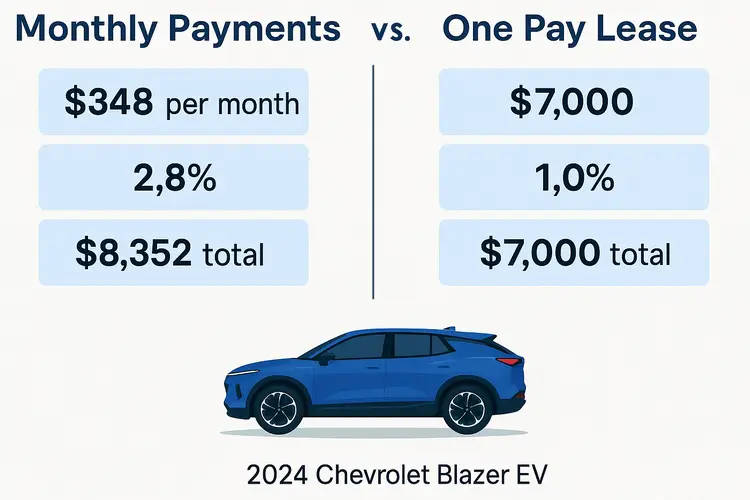Apr 01, 2025
One Pay Car Lease Option: Guide with Examples, Calculations, and Expert Advice
Aug 18, 2025
A one pay car lease — also known as a prepaid lease or Single Payment Lease — is very similar to a standard auto lease. You still get the vehicle for a set term, typically two or three years, with the option to either return it or buy it at the end of the lease term. The main difference is that you make a single upfront payment covering the entire lease term.
In many cases, this approach can save you money. However, there are certain risks and downsides to consider before choosing it. So, is it worth paying the full amount upfront and avoiding monthly payments? Let’s go over the pros, cons, and real-world savings with a practical example.
In this article, you’ll learn:
- One Pay Car Lease meaning
- The different types of one pay lease structures
- How much you can save — with a real calculation example
- The pros and cons of prepaying your lease
- How to qualify for a one pay lease
- What happens if the car is stolen or totaled
- Who is a Single Payment Lease Suitable for?
- When this leasing format is truly worth it
What is One Payment Lease
A one pay car lease is an agreement where you make a single payment at signing that covers the entire cost of the lease term. This often results in a reduced money factor and a lower overall cost, while eliminating monthly bills.
A prepaid lease is usually cheaper than paying monthly because your payment covers the vehicle’s depreciation over the term. You pay interest only on the residual value — the estimated value of the car at the end of the lease — not on the entire vehicle price.
One Pay Lease Explained
With a one pay lease, you lease the vehicle for a standard term (usually 24–36 months), but instead of making 24–36 smaller payments, you make one large upfront lump-sum payment at signing. This format is often referred to as a Single Payment Lease or Prepaid Lease. It eliminates monthly payments, which typically include financing charges.
At first glance, it may seem like prepaying your lease will eliminate all finance charges and interest. While it does remove some costs and can lower your interest rate, the system works a bit differently than it may appear.
You’ll be able to draw accurate conclusions only after understanding how a one pay lease works, the advantages it can provide, the risks it involves, and the potential savings you can calculate.
How It Works
- Choose your vehicle, lease term, and mileage allowance
- Pay the full one pay lease cost upfront at signing
- At the end of the term, return the vehicle or purchase it for its residual value
The key difference is that the leasing company receives the full expected payment upfront, which is why they often reduce the money factor — lowering your finance charges. However, keep in mind that at lease-end, you may still face extra costs such as:
- Excess mileage charges
- Fees for excessive wear and tear
- Repairs for damage not covered by insurance
- Unauthorized modifications
Types of One Pay Car Lease Structures
Different finance companies use different methods to calculate one pay car leases, but in practice there are two main approaches:
1. Depreciation-Based Method (More Beneficial for the Customer)
You pay for the vehicle’s depreciation over the full lease term, plus sales tax and interest — but interest is charged only on the residual value, not on the full vehicle price.
The savings come from avoiding interest on the depreciation amount, which typically makes up about half of the total interest in a traditional lease.
2. Monthly Payment Summation Method (More Beneficial for the Dealer)
The monthly payment is calculated in the standard way and then multiplied by the number of months in the lease term.
This method results in minimal savings, though a small reduction in the money factor may still be offered.
Tip: Before signing, confirm with your dealer or finance manager which method will be used to determine your one pay lease cost — your potential savings depend directly on it.
How Much Can You Save?
Savings depend on the vehicle model, lease term, and — most importantly — the calculation method.
Let’s take an example of a 2024 Chevrolet Blazer EV on a 24-month lease. In this case, we’ll use the Monthly Payment Summation Method (#2), as it’s the most common.
| Parameter | Monthly Payments | One Pay Lease |
|---|---|---|
| Term | 24 months | 24 months |
| Average “effective” rate | 2.8% | 1.0% |
| Total cost | $8,352 | $7,000 |
| Upfront payment | $0 | $7,000 |
| Average monthly cost | $348 | $291 |

Result: Savings of about $57 per month, thanks to a reduced money factor from 0.00120 to 0.00042. Such a low interest rate is unlikely to be available under normal conditions, even with strong negotiation skills.
Pros and Cons of a One Pay Lease
One of the main benefits of a one pay lease is the reduced one pay lease interest rates. But beyond saving on interest, you also gain:
- No monthly payments — perfect for those who don’t want to keep track of bills.
- Easier approval — a large upfront payment can help if you have an average credit history.
- Potential tax advantages in some states (especially when trading in a vehicle).
The biggest obstacle is the need for a significant upfront payment. That money could otherwise be invested to generate potential returns. Additional drawbacks include:
- Risk of losing part of your payment if the vehicle is stolen or totaled (see below).
- Less flexibility — not all makes and models offer this option, and early termination or lease swaps are more difficult.
Credit Requirements for a One Pay Car Lease
Since prepayment reduces risk for the lender, qualification criteria may be less strict than for a traditional lease. However, they still remain relatively high.
While you won’t risk late monthly payments, the lease will still appear on your credit report until the vehicle is returned. To qualify, you generally need a credit score of at least 620. For the best rates, aim for FICO 700+.
Risks: What If the Car Is Stolen or Totaled?
If your leased car is stolen or declared a total loss during the lease term, your insurance will only pay the actual cash value (ACV) — not the total amount you prepaid. This means you could lose part of your payment.
The best way to avoid this is to ensure GAP coverage is included in your lease contract. GAP insurance covers the difference between what your insurance pays and the remaining balance owed on the lease. You would only be responsible for the deductible (see “Lease Terminology” for details). Fortunately, GAP coverage is often included in premium brand leases.
Who Should Consider a Single Payment Lease?
A Single Payment Lease is a good choice if:
- You have available funds and want to save money.
- You want to reduce your monthly debt obligations.
- Your income is unstable, and you’d rather pay upfront than risk missed payments.
- You plan a short lease term (12–24 months), which is less expensive from the start.
- You have a credit score in the mid or slightly below average range.
You can also use this type of lease if you have a trade-in with enough equity to cover the cost. In many states, this can reduce the sales tax on your new vehicle, as most states offer a sales tax credit for trade-ins.
Bottom Line: Is a One Pay Car Lease Worth It?
A one pay car lease can be a cost-saving option, but only if calculated correctly. If the dealer uses the first calculation method and offers a reduced money factor, you could save between $500 and $2,000 over the lease term. The second, more common method, may yield only minimal savings.
Tip: Always request both sets of numbers from your dealer — monthly payments and one pay — and compare the total cost.
In essence, a One Pay Car Lease is similar to making a large down payment on a traditional lease. You can estimate the potential benefit using our Lease Down Payment Impact Calculator.
Three Tips Before Signing
- Check if GAP insurance is included in the contract.
- Confirm the calculation method (depreciation-based vs. monthly payment summation).
- Calculate the actual savings in dollars, not just percentages.
- Avoid this option if you plan to replace the vehicle before the lease ends.








